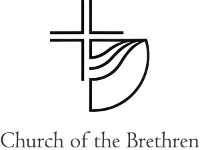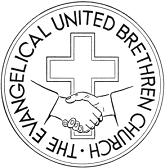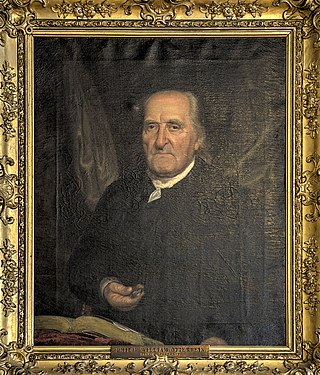Related Research Articles

The Church of the Brethren is an Anabaptist Christian denomination in the Schwarzenau Brethren tradition that was organized in 1708 by Alexander Mack in Schwarzenau, Germany during the Radical Pietist revival. The denomination holds the New Testament as its only creed. Historically, the church has taken a strong stance for nonresistance or Christian pacifism—it is one of the three historic peace churches, alongside the Mennonites and Quakers. Distinctive practices include believer's baptism by forward trine immersion; a threefold love feast consisting of feet washing, a fellowship meal, and communion; anointing for healing; and the holy kiss. Its headquarters are in Elgin, Illinois, United States.

The Evangelical United Brethren Church (EUB) was a North American Protestant denomination from 1946 to 1968 with Arminian theology, roots in the Mennonite and German Reformed, and communities, and close ties to Methodism. It was formed by the merger of the Evangelical Church and the Church of the United Brethren in Christ. The United Brethren and the Evangelical Association had considered merging off and on since the early 19th century because of their common emphasis on holiness and evangelism and their common German heritage. In 1968, the United States section of the EUB merged with the Methodist Church to form the United Methodist Church, while the Canadian section joined the United Church of Canada.
The Church of the United Brethren in Christ is an evangelical Christian denomination with churches in 17 countries. It is Protestant, with an episcopal structure and Arminian theology, with roots in the Mennonite and German Reformed communities of 18th-century Pennsylvania, as well as close ties to Methodism. It was organized in 1800 by Martin Boehm and Philip William Otterbein and is the first American denomination that was not transplanted from Europe. It emerged from United Brethren churches that were at first unorganized, and not all of which joined this church when it was formally organized in 1800, following a 1789 conference at the Otterbein Church.
The Confessing Movement is a largely lay-led theologically conservative Christian movement that opposes the influence of theological liberalism and theological progressivism currently within several mainline Protestant denominations and seeks to return them to its view of orthodox doctrine, or form a new denomination and disfellowship (excommunicate) them if the situation becomes untenable. Those who eventually deem dealing with theological liberalism and theological progressivism within their churches and denominations as not being tenable anymore would later join or start Confessional Churches and/or Evangelical Churches that continue with the traditions of their respective denominations and maintaining orthodox doctrine while being ecclesiastically separate from the Mainline Protestant denominations.

A united church, also called a uniting church, is a denomination formed from the merger or other form of church union of two or more different Protestant Christian denominations, a number of which come from separate and distinct denominational orientations or traditions. Multi-denominationalism, or a multi-denominational church or organization, is a congregation or organization that is affiliated with two or more Christian denominations, whether they be part of the same tradition or from separate and distinct traditions.
The Methodist Church was the official name adopted by the Methodist denomination formed in the United States by the reunion on May 10, 1939, of the northern and southern factions of the Methodist Episcopal Church along with the earlier separated Methodist Protestant Church of 1828.
The Congregational Christian Churches were a Protestant Christian denomination that operated in the U.S. from 1931 through 1957. On the latter date, most of its churches joined the Evangelical and Reformed Church in a merger to become the United Church of Christ. Others created the National Association of Congregational Christian Churches or joined the Conservative Congregational Christian Conference that formed earlier in 1945. During the forementioned period, its churches were organized nationally into a General Council, with parallel state conferences, sectional associations, and missionary instrumentalities. Congregations, however, retained their local autonomy and these groups were legally separate from the congregations.
The Evangelical Church or Evangelical Association, also known in the late 1700s as the New Methodist Conference and in the early 1800s as the Albright Brethren, was a "body of American Christians chiefly of German descent". It was Wesleyan–Arminian in doctrine and theology, as well as Methodist Episcopal in its form of church government.

Jacob Albright was an American Christian leader, founder of Albright's People which was officially named the Evangelical Association in 1816. This church as a denomination is still in existence, headquartered in Myerstown, Pennsylvania.
The Evangelical and Reformed Church (E&R) was a Protestant Christian denomination in the United States. It was formed in 1934 by the merger of the Reformed Church in the United States (RCUS) with the Evangelical Synod of North America (ESNA). A minority within the RCUS remained out of the merger in order to continue the name Reformed Church in the United States. In 1957, the Evangelical and Reformed Church merged with the majority of the Congregational Christian Churches (CC) to form the United Church of Christ (UCC).
The Church of the United Brethren in Christ (New Constitution) was a Protestant Christian denomination with Arminian theology, roots in the Mennonite and German Reformed communities, and close ties to Methodism that formed in 1889 by a majority of the Church of the United Brethren in Christ when that denomination (of a similar tradition) amended the church constitution to give local conferences proportional representation at the General Conference; to allow laymen to serve as delegates to General Conference; and to allow United Brethren members to hold membership in secret societies. The constitution's amendment procedure of the day made amendments all but impossible, but denominational leaders felt these changes were necessary for the good of the church.
The National Association of Congregational Christian Churches (NACCC) is an association of about 400 churches providing fellowship for and services to churches from the Congregational tradition. The Association maintains its national office in Oak Creek, Wisconsin, a suburb of Milwaukee. The body was founded in 1955 by former clergy and laypeople of the Congregational Christian Churches in response to that denomination's pending merger with the Evangelical and Reformed Church to form the United Church of Christ in 1957.
Ecclesiastical polity is the operational and governance structure of a church or of a Christian denomination. It also denotes the ministerial structure of a church and the authority relationships between churches. Polity relates closely to ecclesiology, the study of doctrine and theology relating to church organization.

Philip William Otterbein was an American clergyman. He was the founder of the United Brethren in Christ, which merged with the Evangelical Church in 1946 to form the Evangelical United Brethren Church. That church merged with the much larger Methodist Church in 1968, forming the United Methodist Church.
The Evangelical Church of North America (ECNA) is a Wesleyan-Holiness, Protestant Christian denomination headquartered in Clackamas, Oregon. As of 2000, the Church had 12,475 members in 133 local churches. The Church sponsors missionaries in seven countries.

The United Church of Christ in the Philippines is a Christian denomination in the Philippines. Established in its present form in Malate, Manila, it resulted from the merger of the Evangelical Church of the Philippines, the Philippine Methodist Church, the Disciples of Christ, the United Evangelical Church and several independent congregations.
Bishop John Jacob Esher was bishop of the Evangelical Association in Chicago, Illinois. In 1890-1891 he presided over a schism in the Evangelical Church and his followers were dubbed Esherites and they opposed the breakaway Dubsites. This led to the formation of the United Evangelical Church by the Dubsites.
Bishop Rudolph Dubs was bishop of the Evangelical Association. In 1890-1891 he presided over a schism in the Evangelical Church and his followers were called Dubsites. His detractors were Esherites, followers of John Jacob Esher. His faction broke away to form the United Evangelical Church.
The National Association of Wesleyan Evangelicals is a Wesleyan-Holiness Christian network of churches and ministers concentrated mostly in the Southern United States.
References
- ↑ "Evangelical Congregational Church history" . Retrieved 2014-07-19.
Pastors and laity either identified with the majority, commonly called "The Esherites," or the minority, commonly called "The Dubsites" ... "The Esherites" met in Indianapolis while "The Dubsites" met in Philadelphia. The authority of the majority party prevailed and the ministers and congregations that supported the minority party were excluded from the denomination. These congregations lost their church buildings since the buildings were owned by the denomination. Efforts to reconcile the parties failed and, by 1894, the minority party had reorganized into a new denomination, the United Evangelical Church.
- ↑ "The Esher-Dubbs Fight. Big Evangelical Row In Court At Des Moines" (PDF). New York Times . December 8, 1892. Retrieved 2014-07-19.
The controversy between the Esher and Dubbs factions of the Evangelical Church has got into the Iowa courts and is occupying the attention of Judge Conrad of this district. The case was brought in the form of a petition for an injunction restraining the Esher faction from gaining possession of the church property in Des Moines, and involves the three churches of the Evangelical Association of this city. ... For many years there has been growing dissatisfaction with the despotic character of Bishop Esher's administration. ...